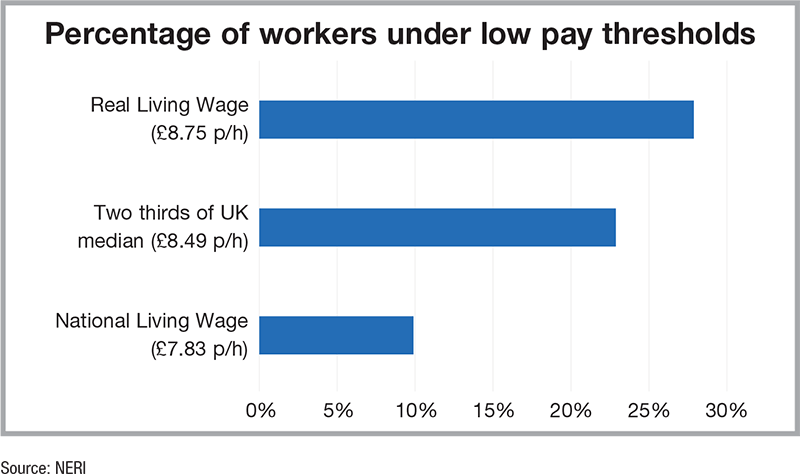Over a quarter of workers earning less than Real Living Wage

A recent report into the pay of workers in Northern Ireland by the Nevin Economic Research Institute has found that 28 per cent of workers, or 219,00 employees, earned less than the Real Living Wage of £8.75 per hour in 2018.
Writing in her brief for the report, NERI economist and report author Lisa Wilson says that “low pay is a prominent feature of the labour market” and that it “should be concerning to policy makers in Northern Ireland not only because of its negative impact for the living standards of individual workers and their families, but also because of its implications for the economy”.
With 28 per cent of workers earning less than the Real Living Wage, 10 per cent, 78,000 employees are also earning under the lower level of the National Living Wage, £7.83 per hour. A further 23 per cent earned under two-thirds below the UK’s median hourly pay (excluding overtime) of £8.49 per hour.
The report found that “some workers are more likely to be low paid than others with concentrations of low paying jobs found in particular occupations and industries and among workers with particular characteristics”. It was found that 70 per cent of workers in sales and customer service and elementary occupations earned less than the Real Living Wage, with 30 per cent of sales and customer service and 20 per cent of elementary occupational workers earning less than the National Living Wage.
Younger, female and part-time workers were all reported to have a higher likelihood of earning underneath these pay thresholds, although Wilson adds that “low pay is a particular issue for male workers who are employed on a part-time basis”.
Operating under the accepted European definition of low-paid – those earning “an hourly wage which is less than two thirds of the median gross hourly wage” – Wilson surmises that the aforementioned 23 per cent of workers earning under that level in Northern Ireland can be classified as low pay workers for 2018.
Using the metric of the Real Living Wage, calculated by adding up the cost of a basket of household goods and services considered by the public to be “necessary to obtain a minimum acceptable standard of living”, which Wilson calls “a much more robust indicator of low pay”, the proportion of low-paid workers rises to 28 per cent in 2018. The Real Living Wage has been revised to £9 per hour for 2019. These figures, along with the 10 per cent of those reported to be earning under the National Living Wage, the national minimum wage for workers over 25, do include workers exempted from the minimum wage, such as workers under 25 and apprentices.
Wilson’s work found that “examination of the sectoral breakdown of low pay shows that the problem of low pay is persistent across almost all sectors”, but that “workers in some sectors at an increasingly higher risk of being low paid”. 75 per cent of workers in the accommodation and food sector were paid beneath the Real Living Wage, with 40 per cent under the National Living Wage. 53 and 25 per cent of workers in the retail and wholesale trade sector earned beneath the Real and National Living Wage thresholds respectively. Again, 25 per cent of workers in the administrative and support services sector earned less than the National Living Wage, while 51 per cent were beneath the Real Living Wage.
40 per cent of processing, plant and machine operatives, along with caring, leisure and other service occupations were found to be earning beneath the Real Living Wage, with 10 per cent of those also earning under the National Living Wage.
Wilson’s work found that the “risk of being low paid declines with age”, with 60 per cent of all workers between the ages of 18 and 21 beneath the National Living Wage and 80 per cent under the Real Living Wage. Middle-aged workers were much less likely to be low paid, with 8 per cent of those between 40 and 49 earning less than the National Living Wage and 17 per cent of them earning less than the Real Living Wage. These figures do begin to rise in older categories, with 20 per cent of those between 50 and 59 earning beneath the Real Living Wage and 9 per cent beneath National Living Wage. These rise again for those over 60, where 10 per cent earn less than the National Living Wage and 23 per cent under the Real threshold.
Part-time workers were also found to “face a much greater risk of being low-paid than full-time workers”, with over half of part-time workers earning less than the Real Living Wage and one in four earning less than the national equivalent. However, it is added that full-time work is “not a guaranteed escape from low pay” with one in 10 in full-time work earning below the National Living Wage and one in five beneath the Real Living Wage.
Females are more likely to be affected by low pay conditions, with 30 per cent of female workers earning below the Real Living Wage threshold in 2018, as compared to 23 per cent of male workers. Conversely, the risk was shifted onto male workers when the numbers were concentrated into part-time workers. 30 per cent of part-time male workers earned below the National Living Wage, and 52 per cent below the Real Living Wage in 2018, compared to 20 per cent and 45 per cent of females respectively.
To address these issues, Wilson calls for “policies directed at increasing the wage levels of those groups of workers who are most likely to be low paid”, which she says, “will be particularly beneficial to ensuring that work pays”. While admitting that “legal wage floors do provide one valuable tool for protecting and sustaining the wages of some of the most vulnerable workers”, Wilson contends that “more needs to be done to tackle the problem of low pay”.
Wilson calls especially for those in charge to make serious efforts to “reduce the proportion of workers earning below the Real Living Wage”. She concludes by calling for workers to assert their rights through traditional labour negotiating tactics, saying that “serious consideration needs to be given to using collective bargaining agreements and sectoral orders set through a forum for social dialogue as an avenue to ensure decent pay for all workers”.






